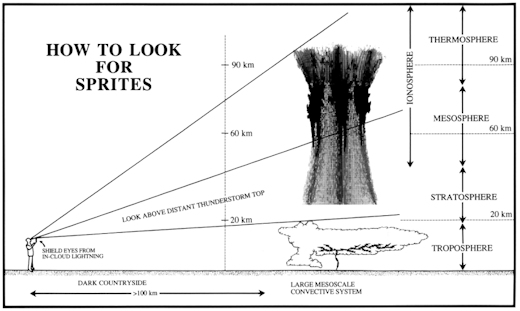This story is at http://spaceweather.com (30th April 2019) which could also have the title – how to look for sprites …
 … a large hole in the Sun's atmosphere is facing the Earth and sending us a stream of solar wind. Minor auroral displays are expected. Meanwhile, sprites that appear above the thunder clouds disappear in a blink yet one man claims to be able to spot them (without a telescope). He adds that he thinks that prior to the era of light polution they were being observed more often than we know. They are said to be an exotic form of lightning that leaps upwards from storm clouds, somewhat like the lightning that leaps from the eye of a tornado. Sprites have been reported for over a hundred years but scientists refuted the idea. They did not accept they existed until after 1989 when sprites were accidentally photographed by a researcher from the University of Minnesota, subsequently confirmed by video camera onboard the space shuttle. Well I never.
… a large hole in the Sun's atmosphere is facing the Earth and sending us a stream of solar wind. Minor auroral displays are expected. Meanwhile, sprites that appear above the thunder clouds disappear in a blink yet one man claims to be able to spot them (without a telescope). He adds that he thinks that prior to the era of light polution they were being observed more often than we know. They are said to be an exotic form of lightning that leaps upwards from storm clouds, somewhat like the lightning that leaps from the eye of a tornado. Sprites have been reported for over a hundred years but scientists refuted the idea. They did not accept they existed until after 1989 when sprites were accidentally photographed by a researcher from the University of Minnesota, subsequently confirmed by video camera onboard the space shuttle. Well I never.
![]() This guy has developed a way to see them without any other means but his eyeballs. Mind you, the praire country of Oklahoma and Kansas tends to get a lot of storms – and the sky is huge. They don't call it the Big Country for nothing. The underlying physics of sprites is still not established. Some scientists use models that say cosmic rays kick start them by creating conductive paths in the atmosphere – and at the moment there are a lot of cosmic rays (as we are in solar minimum).
This guy has developed a way to see them without any other means but his eyeballs. Mind you, the praire country of Oklahoma and Kansas tends to get a lot of storms – and the sky is huge. They don't call it the Big Country for nothing. The underlying physics of sprites is still not established. Some scientists use models that say cosmic rays kick start them by creating conductive paths in the atmosphere – and at the moment there are a lot of cosmic rays (as we are in solar minimum).
Meanwhile, students of Earth to Sky Calculus launched a VLF radio to the edge of space. Its mission is to detect lightning at record setting altitudes. It is 34,518m above the Sierra Nevada and White Mountains of central California. Hopefully it will shed some light on sprites.
In addition, Earth is approaching a stream of debris left behind by Comet Halley (the annual Aquarid meteor shower). The peak is expected on May 4th to 6th with 40 meteors per hour. Listen for the crackle and pops. Mind you, it will also be full moon so it is possible you will get a good view – in the wee small hours just before dawn. See http://spaceweather.com (28th April 2019).
